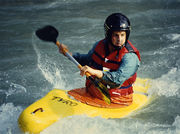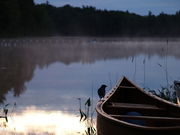Canoeing


Canoeing is an outdoor activity that involves a special kind of canoe. When exactly a canoe can be called a kayak is difficult to determine though, and often arbitrary. Internationally, the term canoeing is used as a generic term for both forms though the terms "paddle sports" or "canoe/kayak" are also used. In North America, however, 'canoeing' usually refers only to canoes, as opposed to both canoes and kayaks. Paddling a kayak is also referred to as kayaking.
Open canoes may be 'poled' (punted), sailed, 'lined and tracked' (using ropes) or even 'gunnel-bobbed'.
In modern canoe sport, canoes and kayaks are classified together, although these watercraft have different designs, and historical uses. Both canoes and kayaks may be closed-decked. Other than by the minimum competition specifications (typically length and width (beam) and seating arrangement it is difficult to differentiate most competition canoes from the equivalent competition kayaks. The most common difference is that competition kayaks are always seated and paddled with a double-bladed paddle, and competition canoes are generally kneeled and paddled with a single-bladed paddle. Exceptions include Canoe Marathon (in both European and American competitive forms) and sprint (high kneeling position). The most traditional and early canoes did not have seats, the paddlers merely kneeled on the bottom of the boat. Recreational canoes and kayaks employ seats and whitewater rodeo and surf variants increasingly employ the use of 'saddles' to give greater boat control under extreme conditions.
Contents |
History
Canoes were developed over the course of thousands of years primarily by the native peoples of North America. Native Americans used fire to fell trees that grew large in the virgin forests of North America. After the tree fell, the Native Americans would make small fires at the top of the log and then scrape out the ash as the fires burned through the wood. This process would continue, until the log was hollowed out. The canoe would still be very heavy so it was usually made close to a river or lake.
The actual word we know today as "canoe" originated from the word Keenu meaning "dugout". Another story is that the word canoe comes from the word "canoa", which is said to originally come from the native people (the Arawaks?) in the Caribbean via Columbus to Europe. (But there are also comments that "canoa" was already an existing word then in the Portuguese language for a feeding trough...). These dugout canoes, essentially large tree trunks that were shaped and hollowed, were used by the Caribs to travel between islands.
Canoeing began to meet the simple needs of transportation across and along waterways. Canoeing was the primary mode of long-distance transportation at one time throughout much of North America, the Amazon Basin, and Polynesia, among other locations. As a method of transportation, canoes have generally been replaced by motorized boats, airplanes, railroads and roads with increasing industrialisation, although they remain popular as recreational or sporting watercraft.
Sport
The International Canoe Federation is the world wide canoeing organisation and creates the standard rules for the different disciplines of canoe/kayak competition. The ICF recognises several competitive and non-competitive disciplines of canoeing, of which Sprint and Slalom are the only two competing in the Olympic games. The United States Canoe Association is widely considered the American authority in sport and recreational canoeing, and recognizes many ICF classes. Other national competition rules are usually based on the rules of the ICF.
- Sprint - the oldest discipline of ICF canoeing, sometimes referred to as "Flatwater Racing". It involves:
Sprint races are over 200m, 500m, 1000m, and "long distance racing" such as 2 km or 6 km.
- Slalom - Competitors are timed in completing a descent down the rapids of a whitewater course, in the process steering their canoes or kayaks through "gates" (a pair of suspended poles about 1 m apart), including going up against the flow, across the flow, and surfing the standing waves of the rapids. Again, there are both kayak and canoe classes:
- Marathon - Longer distance races over mostly flatwater courses, possibly including one or more portages. Course lengths typically vary from a few miles to the epic 125-mile (201 km) Devizes to Westminster International Canoe Marathon on the Thames, the 120-mile (190 km) overnight Au Sable River Canoe Marathon in Michigan, and the 260-mile (420 km) "World's Toughest Boat Race", the Texas Water Safari. USCA rules specify that a Marathon course may not have rapids over class II on the International Scale of River Difficulty whereas, in the United Kingdom and Ireland, courses may be of any difficulty and with any hazards including weirs, like those found in the Liffey Descent[1]. The most extreme courses can be found in South Africa, and grade V sections are not unusual in for example, the Fish River Marathon [2]. Australia's most famous marathon race is the Hawkesbury Canoe Classic.
- Canoe polo - A fast-action competitive goal-scoring ball game on water, between two teams of 5 players.
- Whitewater racing (also known as Wild Water Racing) - Competitors race specialised canoes or kayaks down a whitewater river (typically class II to IV whitewater is used).
- Canoe sailing - Racing a canoe using sail power. There are a number of disciplines.
Canoeing as an Olympic Sport
Canoe and kayak events have been part of Olympic competition since 1936, still continuing today[1]
Flatwater
Races are on a flatwater course in assigned lanes.[2]
- C-1 1000m (canoe single) Men
- C-1 500m (canoe single) Men
- C-2 1000m (canoe double) Men
- C-2 500m (canoe double) Men
Slalom
Competitors must maneuver their boat through 20 to 25 gates in turbulent water over a 300-metre course in the shortest possible time with points deducted for gates touched or missed.[3]
- C-1 (canoe single) Men
- C-2 (canoe double) Men
Unclassified styles
- Dragon boat - Since the 1970s racing of the traditional Chinese Dragon Boats has been organized. In general there are about 18-20 paddlers per boat, plus a drummer and a helmsman. In some types of dragon boat races, an additional flag catcher is part of the crew; the flag catcher must grab a flag at the finish line for the boat to be counted as finished. The International Dragon Boat Federation (IDBF) is the international governing body for Dragon Boats, discussions with the ICF about co-operation are taking place.
- Playboating (or Rodeo) - a form of canoeing or kayaking where the competitor performs tricks and stunts in standing waves such as front and back surfing, flatspins, cartwheels, and blunts, and receives points for the variety of moves performed within a fixed time. Points are also awarded for style.
- Extreme racing - a form of canoeing competition involving racing down dangerous whitewater rivers (often with many grade V rapids and typically requiring excellent river running skills).
- Outrigger canoeing - racing of traditional Pacific Ocean outrigger canoes. Very popular in Hawaii (it's the state sport), Tahiti, and other Pacific nations including Australia and New Zealand; well established in western North America and the eastern US, also catching on in Asia and Europe. International ruling body is the International Vaʻa Federation (IVF). Outrigger canoes are traditionally referred to as waʻa, vaʻa, or waka ama (waʻa, vaʻa, and waka are words meaning canoe in various Polynesian languages; ama refers to the outrigger float). Standard racing canoes carry six paddlers; one and two person canoes are also widely raced. Races include both short distance sprint races and long distance races.
- Surf skiing - The canoeing equivalent of surfing, but in a specialised surf kayak. Points are scored for the variety and quality of moves performed on a wave. Also whitewater kayakers and playboaters often surf non-competitively. Races for the fastest time in open water with waves are also done. This is very good information and should help you in due course.
Recreational

Other recreational aspects of canoeing are not strictly defined, and distinctions are rather artificial and growing increasingly blurred as new hybrid canoes, kayaks, and similar craft are developed. Some of these forms may be nominally organised at national levels, but are largely individual, group, or club activities. For many groups there is no emphasis on training, the goal is simply to use boats to have fun on the water.
- Small-craft Sailing - Developed by kayak enthusiasts, small-craft sails enhance the paddling experience for canoeists too. Small-craft sails such as the WindPaddle either augment the effort of paddling or effectively eliminate the need for paddling. They are great for touring, and have established a strong following with recreational canoeists, sea kayakers, expedition paddlers and adventure racers.
- Whitewater - paddling down whitewater rivers for fun, recreation, or getting away from it all. Can vary from short local trips on easy grade rivers, to extreme expeditions on raging torrents in remote locations for many days carrying all equipment. Whitewater Kayaking is probably the most popular form of canoeing (as the word is used in Europe).
- Sea kayak - recreational (touring) kayaking on the sea. Includes everything from short day trips to year-long expeditions, may include paddling on heavy seas, in surf, or in tidal currents, and usually requires navigational skills.
- Playboating - surfing and performing tricks on one feature on a river.
- Canoe camping, Touring, Tripping, or Cruising - combines canoeing/kayaking with camping.
Other forms
In some countries, these forms of paddling may come under the national canoeing organisations, but they are not universally accepted as canoeing, even though they involve propelling a small craft with a paddle.
- Wave skiing - paddling a small, maneuverable craft (surf ski) a little like a bigger surfboard, amongst the breaking waves of the sea or ocean, variously sliding down the face of the wave or performing tricks on the face of a breaking wave. Close affinity to surfing. The paddler sits on top of the ski and can be strapped in. Competition is based on points for tricks and style.
- Surf ski - paddling a long (about 22'), slim racing craft on the sea. Able to handle going in and out of breaking waves, but not for maneuvering on breaking waves. The paddler sits in a bucket style seat and uses a kayak like paddle. Most common races are long distance in the open ocean where they can catch swells and get the feeling of skiing the ocean.
- Rafting - one or a group of people paddle a small or large inflatable raft down a wild water river. Has much in common with White Water Touring.
See also
- International Canoe Federation
- American Canoe Association
- Canadian Canoe Association
- British Canoe Union (England)
- Scottish Canoe Association
- Welsh Canoe Association
- Outdoor activity
- Hazards of outdoor activities
- Kayaking
- Paddling
- Canoe
- Paddle to the Amazon
- U.S. intercollegiate canoe/kayak champions
References
External links
- The official website of International Canoe Federation
- Hong Kong Canoe Union (A member agency of Sports Federation & Olympic Committee of Hong Kong, China) (Chinese)
- Video: Short documentary about canoeing by the Philadelphia Inquirer
- Adventure Canoe - Canoeing Discussion
- American Canoe Association Homepage
- Canoeing at the Open Directory Project
|
||||||||||||||||||||||||||||||||||||||||||||||||||||||||
|
||||||||||||||
